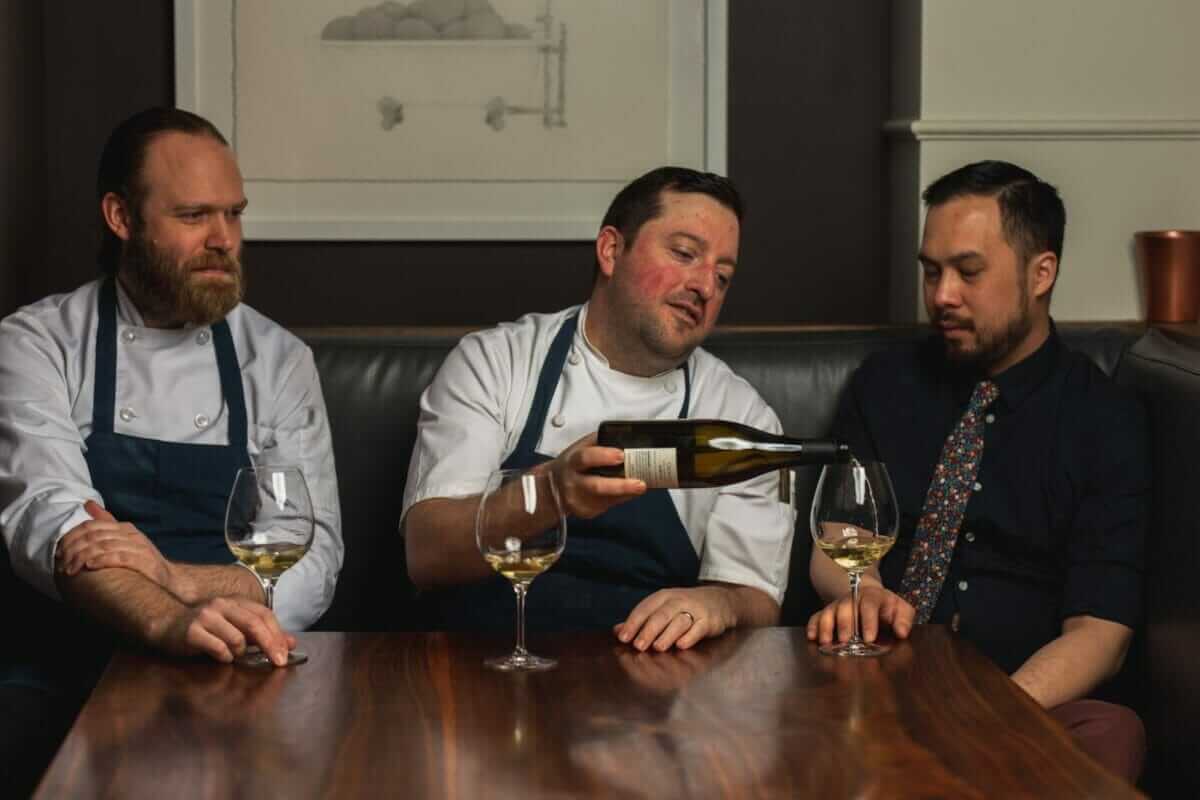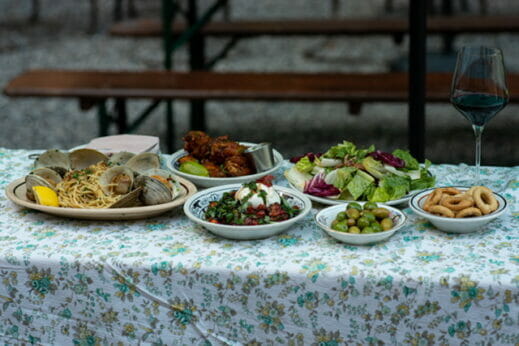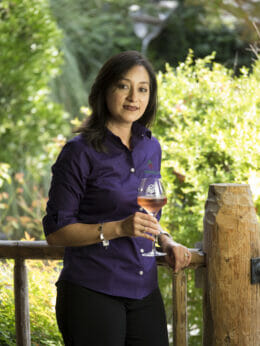Farm-to-Table Doesn’t Always Mean Farm-to-Glass
Why restaurants serving local fare may think globally when it comes to their drink menu.
Farm-to-Table Doesn’t Always Mean Farm-to-Glass
Why restaurants serving local fare may think globally when it comes to their drink menu.

Chef Wyatt VandenBerghe, Chef John Conlin and sommelier Michael Branton of Tercet.courtesy of Tercet
When Charlie Marshall opened his New York City restaurant, The Marshal, in 2013, he was disappointed by the farm-to-table scene in the city.
“It felt really precious. There were these high-end restaurants claiming to be completely committed to the farm-to-table movement, and yet, their wine lists are completely global. It was like, ‘Why serve this local swill? We want wine from Napa and Italy!’” says Marshall. “We decided we would celebrate the fact that New York City is in the heart of one of the best wine regions in the world.”
But it hasn’t always been easy.
“There was a lot of pushback on the wine list when we opened,” explains Marshall. “People would freak out at the idea of drinking a New York Chardonnay instead of one from California. But we learned how to curate the wine list to make it work.”
Marshall offers only wines that are rated 90 points or higher by critics at major media outlets such as Wine Spectator and Wine Enthusiast. While most of the 110 wines on his list are classic, there are “plenty of by the bottle options for people who want to geek out and try something really out there.”
Marshall notes that, today, “New York wines are much more accepted and represented on New York City wine lists. It’s amazing what a difference a decade makes.”
But Marshall is just one of the farm-to-table restaurateurs trying to balance a local ethos with an expectation of global drinks. And things have changed a lot since the farm-to-table movement first took hold.

One of the first gourmet farm-to-table restaurants in the U.S. to enjoy international acclaim was Chez Panisse in Berkeley, California. Opened in 1971, the reception was extraordinary, setting the stage for what was to come over the next several decades.
Between 1994 and 2019, the number of farmers markets grew to 8,771 from 1,755, according to the USDA. Farmers markets and farm-to-fork restaurants are proliferating because most—about 73 percent, according to a Gallup poll—want to support locally grown food. But there was—and is—a catch.
Chefs and restaurateurs look at wine, spirits and beer as a separate category of food in their inventory. Unlike lettuce or beef, which can be produced anywhere, certain types of wine, spirits and beer, by definition, must be made in and procured from certain regions. Think Champagne, Scotch or Berliner Weisse.
Even restaurants in regions that are famous for their locally produced libations, such as California, regularly fly in wine, spirits and beer from across the globe. (It should be noted that Chez Panisse’s drinks list is decidedly global).
To be fair, pairing drinks with thoughtfully crafted cuisine is challenging—and diners who happen to have landed in a farm-to-table restaurant may not be card-carrying members of the Slow Food and Wine movements. At most farm-to-table emporiums, including Chez Panisse, that means the locavore sentiments stop at the kitchen door.
For chef John Conlin, that’s a fair trade to make. The decision came to him during the pandemic, when he had an epiphany.
“I was working as head chef at a fine dining seafood restaurant in Portland, OR that sourced fish from all over the world,” says Conlin. “They were gorgeous, line-caught specimens, but every morning in the kitchen, I’d have to wade through a ton of packaging and Styrofoam to get to the best produce overnighted from 2,000 miles away.”
Meanwhile, he saw his farmer friends struggling to get restaurants to buy their food.
“That’s how Tercet was born,” says Conlin. It offers a seven-course tasting menu sourced from local waters and fields that rotates constantly depending on availability. Its wines, though, have a global footprint.
Sommelier Michael Branton explains in an email that “wine is a bedrock component to the Tercet experience.”
Because their kitchen operates using very specific farm-to-table rules, Branton wanted the wine program to be less limiting, allowing for more creative and diverse pairing options.
Branton doesn’t just bring in anything that catches his fancy though. He focuses on lesser-known vintners from legendary regions such asBourgogne and Napa, especially if they have an interesting story, and strong sustainability initiatives in place.

At Mill & Main in the Hudson Valley town of Kerhonkson, N.Y., Claudia Sidoti explains that many of the wine and food choices she makes are focused on the broadest sense of community. When picking food and wine, she works with her husband, Paul Weathered, and their son Christopher. Their shared cultures influence many of their decisions.
“Paul is West Indian, and I’m half Colombian and half Italian,” Sidoti explains. “Our goal is to source our meat, dairy and produce as much as humanly possible locally but to serve a globally inspired menu that honors all of our roots.”
“Our food is so eclectic, we offer a range of flavors from across the globe,” says Chris Weathered. “We have a Concord grape canned wine from Wild Arc in the Hudson Valley that is absolutely amazing, but we also have selections from Jerez, the Loire, the Willamette Valley. It’s not a huge list, maybe 30 to 35 bottles in total, with an emphasis on natural, low-intervention, sustainably produced wines that occasionally push the envelope.”
Their cocktail program, Sidati notes, is even more ambitious.
“We really wanted to showcase our global roots there,” she says. “Our vibe is very much locally rooted, but [it’s] a reflection of the globe.”
But a commitment to local drinks can be done, and in places you may not expect. Cabernet Grill, perched squarely in Texas Hill Country, transitioned from a global to a Texas-centric wine list after opening in 2001.
“[Our chef] really began to see the potential of Texas wine, and he wanted to support the industry, so he transitioned to all Texas wine in 2006,” says Elizabeth Rodriguez, sommelier and wine director. “The difference between then and now in terms of what is available is incredible. We now offer close to 200 wines from 50 wineries. And the fact that we can offer 42 different grape varietals shows just how diverse Texas wine is and how much potential it has for food pairing.”
Staff members also visited wineries across Texas for in-depth tastings and education so they could understand what they’d be offering guests.
“That commitment to education was really important because there was resistance in the beginning from guests,” says Rodriguez. “But once our staff could educate guests and recommend pairings that would really work, we saw sales of wine actually go way up. Now, people come in specifically for the wines.”
Rodriguez says they rotate flights—sometimes with a focus on one varietal or a vineyard,or a producer—frequently, so guests can try three wines with their meal.
“Our food is classic Texas Hill Country, local sourced, so it’s really fun to pair,” she says. “Our lobster-topped chicken fried ribeye is really popular, and that and many of our other Texas classics pair well with hearty reds, so we sell a lot of Cabernet and Merlot, but [we] also try to introduce guests to some of our fantastic Tannat, Tempranillo and Aglianico.”
Next up: going all in on Texas spirits.
“Right now, we have 18 Texas spirits and eight Texas beers,” says Rodriguez. “Our goal is to offer 100 percent Texas everything.”

In New York, Charlie Marshall attributes the success of the wine, liquor and beer program to the growth and increased success of New York wineries, distilleries and breweries in the past decade.
“It is amazing to see how much talent has come into New York in the past 10 years,” he says. “We’re going to get a local Amaro soon, which means we can make 100 percent New York Negronis.”
The thirst for a local libation to pair with a grass-fed steak or harvest salad sourced from nearby fields does appear to be increasing. Perhaps, in 20 years, a farm-to-table restaurant will, by definition, include a local drinks list as well.
Follow us
This work is licensed under a Creative Commons Attribution-NoDerivatives 4.0 International License.
Want to republish a Modern Farmer story?
We are happy for Modern Farmer stories to be shared, and encourage you to republish our articles for your audience. When doing so, we ask that you follow these guidelines:
Please credit us and our writers
For the author byline, please use “Author Name, Modern Farmer.” At the top of our stories, if on the web, please include this text and link: “This story was originally published by Modern Farmer.”
Please make sure to include a link back to either our home page or the article URL.
At the bottom of the story, please include the following text:
“Modern Farmer is a nonprofit initiative dedicated to raising awareness and catalyzing action at the intersection of food, agriculture, and society. Read more at <link>Modern Farmer</link>.”
Use our widget
We’d like to be able to track our stories, so we ask that if you republish our content, you do so using our widget (located on the left hand side of the article). The HTML code has a built-in tracker that tells us the data and domain where the story was published, as well as view counts.
Check the image requirements
It’s your responsibility to confirm you're licensed to republish images in our articles. Some images, such as those from commercial providers, don't allow their images to be republished without permission or payment. Copyright terms are generally listed in the image caption and attribution. You are welcome to omit our images or substitute with your own. Charts and interactive graphics follow the same rules.
Don’t change too much. Or, ask us first.
Articles must be republished in their entirety. It’s okay to change references to time (“today” to “yesterday”) or location (“Iowa City, IA” to “here”). But please keep everything else the same.
If you feel strongly that a more material edit needs to be made, get in touch with us at [email protected]. We’re happy to discuss it with the original author, but we must have prior approval for changes before publication.
Special cases
Extracts. You may run the first few lines or paragraphs of the article and then say: “Read the full article at Modern Farmer” with a link back to the original article.
Quotes. You may quote authors provided you include a link back to the article URL.
Translations. These require writer approval. To inquire about translation of a Modern Farmer article, contact us at [email protected]
Signed consent / copyright release forms. These are not required, provided you are following these guidelines.
Print. Articles can be republished in print under these same rules, with the exception that you do not need to include the links.
Tag us
When sharing the story on social media, please tag us using the following: - Twitter (@ModFarm) - Facebook (@ModernFarmerMedia) - Instagram (@modfarm)
Use our content respectfully
Modern Farmer is a nonprofit and as such we share our content for free and in good faith in order to reach new audiences. Respectfully,
No selling ads against our stories. It’s okay to put our stories on pages with ads.
Don’t republish our material wholesale, or automatically; you need to select stories to be republished individually.
You have no rights to sell, license, syndicate, or otherwise represent yourself as the authorized owner of our material to any third parties. This means that you cannot actively publish or submit our work for syndication to third party platforms or apps like Apple News or Google News. We understand that publishers cannot fully control when certain third parties automatically summarize or crawl content from publishers’ own sites.
Keep in touch
We want to hear from you if you love Modern Farmer content, have a collaboration idea, or anything else to share. As a nonprofit outlet, we work in service of our community and are always open to comments, feedback, and ideas. Contact us at [email protected].by Kathleen Willcox, Modern Farmer
September 13, 2023
Modern Farmer Weekly
Solutions Hub
Innovations, ideas and inspiration. Actionable solutions for a resilient food system.
ExploreShare With Us
We want to hear from Modern Farmer readers who have thoughtful commentary, actionable solutions, or helpful ideas to share.
SubmitNecessary cookies are absolutely essential for the website to function properly. This category only includes cookies that ensures basic functionalities and security features of the website. These cookies do not store any personal information.
Any cookies that may not be particularly necessary for the website to function and are used specifically to collect user personal data via analytics, ads, other embedded contents are termed as non-necessary cookies.
I know this problem well. My wife and I have an organic orchard that is, by all accounts, the largest collection of organically grown French and English true cider apples in America. We make complex, wine-like ciders and apple brandy that are internationally awarded and recognized. We see local restaurants of all stripes that have well curated wine and beer lists pass on our ciders due to cost and put in one or more horrible mass-market ciders! Oh, well.
I have been wanting to go into this restaurant for at least two years. Me and a group of friends drove in from Houston and made reservations for our birthdays to eat here over a month ago on August 6th. I am heartbroken and appalled at how we were treated last night. We walked in the restaurant with our whole party at 7:15 with a 7:30 reservation I promptly checked in and told them our party was here with two children. Fyi when I made the reservation I put in the notes that there were two children with us and… Read more »